

Frank Kidson - Grove entries. Branle (Fr.)
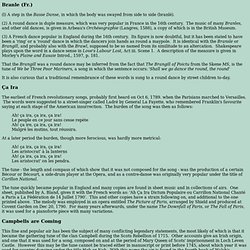
(l) A step in the Basse Danse, in which the body was swayed from side to side (branlé). (2) A round dance in duple measure, which was very popular in France in the 16th century. The music of many Branles, and other old dances, is given in Arbeau's Orchésographie (Langres, 1588), a copy of which is in the British Museum. (3) A French dance popular in England during the 16th century. Its figure is now doubtful, but it has been stated to have been a 'ring' or a 'round' dance in which the dancers join hands as round a maypole. Medieval dance tunes, Hurdy Gurdy - English Heritage. Anglo, Irish, and Scottish Dances.
Central Illinois English Country Dancers Saturdays and Sundays (call for dates) Dances taught by local leaders and the music is by the Flatland Consort at Phillips Recreation Center, 505 W.
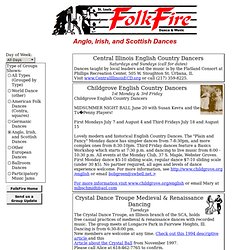
Stoughton St. Urbana, IL Childgrove English Country Dancers 1st Monday & 3rd Friday MIDSUMMER NIGHT BALL June 20 with Susan Kevra and the TuPenny Players! First Mondays July 7 and August 4 and Third Fridays July 18 and August 15 Lovely modern and historical English Country Dances. Crystal Dance Troupe Medieval & Renaissance Dancing Tuesdays The Crystal Dance Troupe, an Illinois branch of the SCA, holds free casual practices of medieval & renaissance dances with recorded music.
Please call Alice at 618-462-7765 to confirm. Highland Mist Scottish Country Dancers Second and Third Saturdays. Styles of Dance. Dance Styles I'm not a particularly good dancer, being part of that generation for which dancing involves shuffling one's feet about randomly while gyrating in provocative ways.
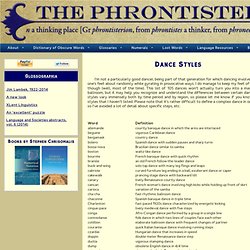
I do manage to keep my feet off my wife's, though (well, most of the time). This list of 105 dances won't actually turn you into a master of the ballroom, but it may help you recognize and understand the differences between certain dances. Rethinking the Dancing Mania. Article Robert E.

Bartholomew Volume 24.4, July / August 2000 While medieval dance frenzies have long been regarded as a classic example of stress-induced mental disorder affecting mostly women, there is much evidence to the contrary. 5 Historical Manias That Gripped Societies, Then Disappeared. “Men, it has been well said, think in herds; it will be seen that they go mad in herds, while they only recover their senses slowly, and one by one.”
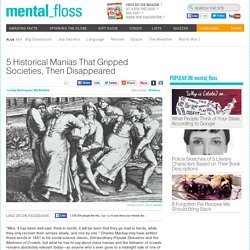
Charles Mackay may have written those words in 1841 in his social science classic, Extraordinary Popular Delusions and the Madness of Crowds, but what he has to say about mass manias and the behavior of crowds remains absolutely relevant today—as anyone who’s ever gone to a midnight sale of one of the Twilight books could tell you. Mob mentality also goes some of the way—but not all the way—in explaining these real manias and outbreaks of strange behavior that came on disturbingly fast and disappeared just as rapidly. Western Social Dance. Dance Instruction Manuals Western Social Dance | 1 | 2 | 3 | 4 | 5 | 6 | 7 | 8 | 9 Soft, mellow musical instruments such as the vielle, (a bowed string instrument), or recorders were used for small, indoor occasions.
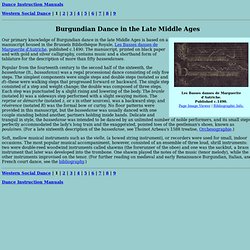
Medieval Dance. Crispin Sexi, March 2006 Introduction In the SCA we do dances from the 17th, 16th and 15th centuries, but none earlier.
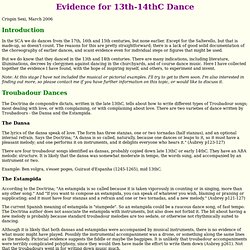
Except for the Salterello, but that is made-up, so doesn't count. The reasons for this are pretty straightforward; there is a lack of good solid documentation of the choreography of earlier dances, and scant evidence even for individual steps or figures that might be used. But we do know that they danced in the 13th and 14th centuries. The history and significance of medieval dance. 1.0 Introduction 1.1 History of dance 1.2 Significance of dance 1.3 The ‘Dance of Death 1.4 Why people danced 1.5 Conclusion 1.6 Bibliography If you are not familiar already in the fifteenth centaury was era commonly referred to as the Dark Ages.
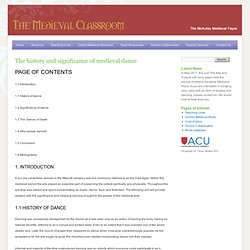
Dancing was excessively disregarded by the church as it was seen only as an action of moving the body, having no rational benefits, referred to as a corrupt and wicked deed. Informal and majority of the time unstructured dancing was an activity which everyone could participate in as it required no special skills however a band was a good accompaniment. (“Medieval dance”, 2006, pg1) A short time later, dance was taken more seriously rather than just a bit of fun. One of the most familiar dancers was Called ‘The Dance of Death, even though it was given this bitter tile it was not to promote death as a destroyer but ironically a message “sent from god, summoning men to the world beyond the grave”.
(BellaOnlines Renaissance editor, 2006, pg 1) Charles G. Medieval Dance. Facts and interesting information about Medieval Life,specifically, Medieval Dance Medieval DanceMedieval dance music dates from the early Medieval period.
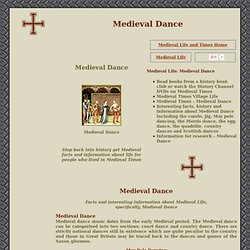
The Medieval dance can be categorised into two sections: court dance and country dance. There are strictly national dances still in existence which are quite peculiar to the country and those in Great Britain may be traced back to the dances and games of the Saxon gleemen. May Pole Dancing.